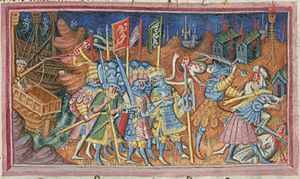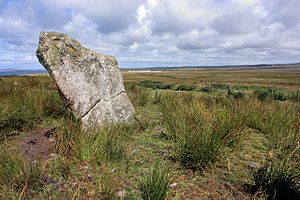Ímar facts for kids
Quick facts for kids Ímar |
|
|---|---|
| King of the Norsemen of all Ireland and Britannia | |
| Reign | 873 |
| King of Dublin | |
| Reign | c. 857–873 |
| Died | c. 873 |
| Issue | |
| Dynasty | Uí Ímair (founder) |
| Father | Gofraid |
Ímar (also known as Ivar the Boneless) was a powerful Viking leader. He lived in Ireland and Scotland in the mid-to-late 800s. He started the Uí Ímair family, which became very important in the Irish Sea area for hundreds of years.
Ímar was the son of Gofraid, a king from a place called Lochlann. His brothers were Auisle and Amlaíb Conung. The old Irish writings called the three brothers "kings of the foreigners." Today, historians often call them "Kings of Dublin" because Dublin was their main base. Some experts think Ímar was the same person as Ivar the Boneless. Ivar was a famous Viking commander of the Great Heathen Army in England. He is also known in old Norse stories as the son of the legendary Viking Ragnar Lodbrok.
In the late 850s and early 860s, Ímar fought against Máel Sechnaill, a powerful Irish king. The reason for their fight might have been to control Munster and its valuable resources. Ímar teamed up with other Irish kings like Cerball and Áed Findliath against Máel Sechnaill. Máel Sechnaill died in 862, and the fighting stopped.
After this, Ímar and his family fought other Irish leaders to make their kingdom bigger. Ímar then disappears from Irish records between 864 and 870. This fits with the idea that he was Ivar the Boneless. Ivar was busy fighting in England during those years. In 870, Ímar and Amlaíb captured Dumbarton Rock, a major fortress in Scotland. Ímar died in 873. He was called "King of the Norsemen of all Ireland and Britain."
Contents
Viking History in Ireland and Scotland
Early Viking Contact
Vikings started visiting Scotland even before the first written records in the 700s. We don't know much about these early visits. But digs on the island of Unst show that Vikings might have settled there by the mid-600s. From 793 onwards, Vikings often raided the British Isles. In 794, "all the islands of Britain" were attacked. The famous monastery of Iona was raided in 802 and 806.
Historians have different ideas about how Vikings settled in Scotland. It's hard to know exactly when and how they took over the islands.
Viking Settlements in Ireland
The first recorded Viking raids in Ireland happened in 795. These raids grew stronger over time. Vikings stayed in Ireland for the first time during the winter of 840–841. In 841, they built a camp called a longphort at a place called Áth Cliath. This place later grew into the city of Dublin. Other Viking camps were built around Ireland. Some of these also grew into bigger settlements.
More Vikings arrived in Ireland in 851. These new Vikings were called "dark foreigners." The Vikings who were already there were called "fair foreigners." Historians used to think "dark" meant Danish and "fair" meant Norwegian. But now, some think it just meant "new" and "old" Vikings. By 853, a separate kingdom of Dublin was set up. It claimed control over all Vikings in Ireland.
Historical Records
The main historical sources for this time are Norse sagas and the Irish annals. Some annals, like the Annals of Ulster, were written as events happened. They are considered very reliable. Sagas, however, were written much later. They are less accurate. Other annals, like the Fragmentary Annals of Ireland, mix real history with parts of sagas. Irish records are mostly accurate, but they can sometimes show bias.
Ímar's Life and Rule
Arriving in Ireland
Ímar is first mentioned in Irish records in 857. This was four years after his brother Amlaíb Conung arrived in Ireland. The Fragmentary Annals of Ireland suggest Ímar came to Ireland soon after Amlaíb. They say Amlaíb brought demands for taxes from their father. Then Ímar came to collect the same taxes.
Their younger brother, Auisle, joined them before 863. From then on, the three brothers were called "kings of the foreigners." Today, they are known as kings of Dublin. Their main power base was the Viking settlement there. Their father was king of Lochlann. This place is often thought to be Norway. But some historians believe it referred to Viking lands in Scotland and the islands.
Fighting Máel Sechnaill
Ímar's first mention in 857 is about a war. He and Amlaíb fought against Máel Sechnaill, a powerful Irish king. Máel Sechnaill ruled lands near Dublin. The fighting started in 856. It was a "Great warfare between the heathens and Mael Sechnaill."
The battles mostly happened in Munster. Máel Sechnaill wanted more control over the kings there. Munster was weakened by Viking raids. This weakness likely attracted both Máel Sechnaill and the Vikings. They both wanted Munster's resources. At first, the Vikings seemed to win. Ímar and Amlaíb defeated a group of Vikings allied with Máel Sechnaill in Munster.
In 858, Ímar teamed up with Cerball, King of Ossory. They defeated another group of Vikings. Ossory was a small kingdom between Munster and Leinster. Cerball had fought Vikings before. But he allied with them to challenge Máel Sechnaill. The next year, Amlaíb, Ímar, and Cerball raided Máel Sechnaill's lands. After this, Cerball left the Vikings and made peace with Máel Sechnaill.
With Cerball gone, Ímar and Amlaíb found a new ally. They joined Áed Findliath, a rival of Máel Sechnaill. In 860, Máel Sechnaill attacked Áed's lands. Áed launched a night attack, but his forces suffered many losses. In return, Amlaíb and Áed raided Máel Sechnaill's lands in 861 and 862. This alliance was strengthened by Amlaíb marrying Áed's daughter. Alliances between the Vikings of Dublin and the Northern Irish kings became common. They often fought against the Southern Irish kings.
Later Years and Death

Máel Sechnaill died in 862. His lands were divided. Ímar and Amlaíb, now joined by their brother Auisle, tried to expand their power. In 863, the three brothers raided Brega. They also killed an Irish king in 863, likely to expand into Leinster.
Around 864, the brothers stopped their campaigns in Ireland. They started fighting in Britain. Ímar disappears from Irish records from 864 to 870. This supports the idea that he was Ivar the Boneless. Ivar was a Viking leader active in England during this time.
Ímar reappears in Irish records in 870. He and Amlaíb attacked Dumbarton Rock, a major fortress in Scotland. They besieged it for four months and captured it. They returned to Dublin in 871 with 200 ships. They brought many captives from England, Scotland, and Wales. According to some records, Amlaíb went back to Lochlann that year to help their father. Ímar was left to rule alone. Auisle had died in 867.
Ímar's father, Gofraid, died in 873. The last mention of Ímar in records is also in 873, when he died. He was called "king of the Norsemen of all Ireland and Britain." By the time he died, Ímar's kingdom was huge. It included Man, the Western Isles, and large parts of Scotland.
Who was Ímar?
Ivar the Boneless Connection

In 865, the Great Heathen Army landed in England. One of its leaders was called "Ingvar." Later Norse stories call him Ivar the Boneless. They say he was a son of the legendary Ragnar Lodbrok. Most historians agree that Ivar the Boneless and Ingvar are the same person. The nickname "the Boneless" appeared much later, and its meaning is unclear.
Many scholars believe Ímar and Ivar the Boneless are the same person. They point to several things. Their names are very similar. Ímar disappears from Irish records when Ivar is active in England. Also, the Viking rulers of Dublin and York (in England) later had strong connections. Ivar is not mentioned in English records after 870, which is when Ímar reappears in Irish records.
However, some historians disagree. They point out that if Ímar was besieging Dumbarton in 870, he couldn't have been in England in 871. The records are not always clear. So, while it's a popular idea, we don't know for sure if Ímar and Ivar the Boneless were the same person.
"Dark" and "Fair" Foreigners
Old Irish records use terms like Dubgaill (dark foreigners) and Finngaill (fair foreigners) for different Viking groups. For a long time, people thought Dubgaill meant Danes and Finngaill meant Norwegians. From 917 onwards, Ímar's descendants were called leaders of the Dubgaill.
However, this idea has been challenged. Some historians now think these terms didn't mean different cultures. Instead, they might have meant "old" and "new" Vikings. The group that arrived with Ímar might have been the "new" or "dark" Vikings. The Vikings already in Ireland were the "old" or "fair" ones.
Ímar's Family
Ímar's father is named Gofraid in the Fragmentary Annals. Some records even give a long family tree for Ímar. But historians think this family tree was made up for political reasons. However, it's likely that Ímar's father, Gofraid, was a real person.
Ímar's brothers, Amlaíb Conung and Auisle, joined him in Ireland. The Annals of Ulster called them "kings of the foreigners." The Fragmentary Annals clearly state they were brothers. They even say Auisle was the youngest but the bravest. He was very skilled in fighting. But his brothers, especially Amlaíb, hated him. The reasons for their hatred are not fully explained. Auisle was killed in 867 by his "kinsmen." The Fragmentary Annals say Amlaíb and Ímar planned his death.
Some experts think Halfdan Ragnarsson was another brother. This idea depends on Ímar being Ivar the Boneless. Halfdan and Ivar are named as brothers in English records. Amlaíb's son was killed by someone called "Albann" in 875. This "Albann" is generally thought to be Halfdan. If true, it means they were fighting over who would rule the kingdom. One problem is that Norse stories say Ivar and Halfdan were sons of Ragnar Lodbrok. But Ímar and Amlaíb are named as sons of Gofraid. However, the stories about Ragnar are not always reliable.
Ímar had three sons who became kings of Dublin: Bárid (died 881), Sichfrith (died 888), and Sitriuc (died 896). Many people are called "ua Ímair" in the records. This usually means "grandson of Ímar." These grandsons include Sitric Cáech, Ímar, Ragnall, Amlaíb, and Gofraid. Most of them ruled as kings in Dublin or Viking Northumbria. We don't know which of Ímar's sons was their father. This might be because their fathers didn't rule Dublin, or they were outside Ireland. So, their right to rule came from their famous grandfather. They might also have been grandsons through a daughter.
Ímar and his descendants are known as the Uí Ímair (meaning "descendants of Ímar"). This family produced many kings of Dublin, Northumbria, and the Isles. Ímar's family controlled the main seaports of Ireland. They also challenged the power of kings in Britain in the late 800s and 900s. Viking power in Ireland weakened after the Battle of Clontarf in 1014. But Ímar's descendants still had influence around the Irish Sea. The Crovan dynasty, who ruled the Isle of Man and the Isles, likely came from Ímar's great-grandson, Amlaíb Cuarán.
Family Tree of Ímar's Descendants
| Notes: |
Images for kids




